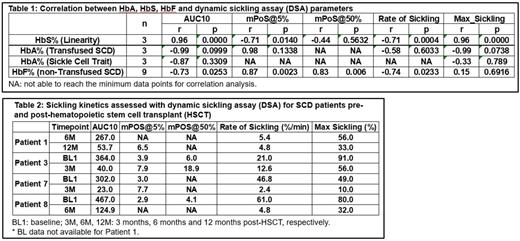INTRODUCTION: Polymerization of deoxygenated sickle hemoglobin (HbS) leads to erythrocyte sickling. Treatment in sickle cell disease (SCD) aims to reduce the risks of red blood cell (RBC) sickling and associated complications including, but not limited to vaso-occlusive crises (VOC). There is substantial promise in developing therapies targeting HbS polymerization that consequently decrease RBC sickling, a fundamental pathophysiological driver of SCD. Nonetheless, there are limited options available for reliable diagnostic tools for the assessment of disease status and therapeutic outcomes. A robust and easy-to-use system to assess population-scale sickling kinetics and to monitor responses to Hb-modifying therapies in clinical trials for the clinical management of patients may be beneficial. We have developed a dynamic sickling assay (DSA) that uses an enzymatic oxygen scavenging system to provide tight control over the rate and depth of induced-hypoxia. DSA is able to differentiate samples based on endogenous Hb expression and can be used to monitor sickling kinetics pre- and post HbS-modifying therapies, including hematopoietic stem cell transplantation (HSCT).
METHODS: SCD and sickle cell trait (SCT) subjects were recruited under the RBC Health Initiative IRB protocol number FF-RBC-003. Four hematopoietic stem cell transplant (HSCT) SCD subjects were enrolled in NIH haploidentical HSCT protocol 17-H-0069. Diluted blood samples were supplemented with protocatechuic acid (PCA), followed by protocatechuate 3,4-dioxygenase (PCD) enzyme inducing hypoxia at a predetermined rate. The sample was then injected into a microfluidic chamber, and resulting RBC morphological changes were observed and captured with time-lapse photography. Image analysis identified and quantified RBC using an AI-trained SICKLE image analysis software. HbAS (n=3), HbSS with HbA (post-transfusion, n=3) and HbSS samples containing 3.1 to 34.5% HbF (n=9) were processed with DSA to assess the effects of hemoglobin distribution on sickling kinetics.Pre- and post-HSCT samples were run to ascertain the effect on sickling kinetics at baseline, 3M, 6M and 12M post-HSCT. Sickling profiles were constructed enabling a comprehensive assessment of RBC sickling and treatment outcomes. The reported parameters include: mPOS@5% (time to reach 5% induced sickling, min), mPOS@50% (time to reach 50% maximum induced sickling,min), rate of sickling (the maximum sickling rate, %/min), maximum induced sickling (the highest induced sickling percentage, %), AUC at 10min (area under the curve@10min of DSA, %∙minute)
RESULTS: DSA inter-run CVs are 6.9% for mPOS@5%, 3.8% for mPOS@50%, 2.7% for max sickling, 4.2% for AUC and 10.8% for the rate of sickling. Statistically significant correlations are observed between %HbS and rate of sickling, max sickling, mPOS@5%, and AUC at 10min. As percentages of Hb increased in transfused SCD patient samples, there were noticeable correlations between the delay in mPOS@5% and decreased rate of sickling, maximum sickling, and AUC10. Similarly, as HbA percentages increased in SCT samples, a decrease in AUC10 and max sickling were observed. Transfused and SCT samples did not show statistical significance due to sample size limitations. However, there was a strong correlation in delay of mPOS@5% and mPOS@50%, as well as a decrease in the rate of sickling and AUC10 with increasing percentages of HbF in samples (Table 1). Comparing pre-HSCT (BL) sample sickling kinetics to 3, 6 and 12 month post-HSCT samples showed decreases in the rate of sickling (from 44.4 to 0.6%), maximum sickling (from 45-23%), decreases in AUC and delays in mPOS (Table 2).
CONCLUSIONS: This study found significant linear relationships between %HbS and sickling parameters.As HbA percentage increases in transfused SCD and SCT samples, improvements in sickling parameters are observed. There is a strong correlation between increased HbF percentage and improved DSA parameters. Comparative data analysis from patients pre- and post-HSCT also show improvement in sickling parameters. Overall, DSA provides a simple, robust method for assessing responses to Hb differences and monitoring SCD therapies such as gene-editing.
Disclosures
Zaidi:Functional Fluidics: Current Employment. Gao:Functional Fluidics Inc: Current Employment, Current equity holder in private company. Goodrich:Functional Fluidics Inc.: Current Employment. Ferranti:Functional Fluidics Inc: Current Employment. Borhan:Functional Fluidics: Current Employment. Liu:Functional Fluidics Inc.: Current Employment, Current equity holder in private company. Okeke:Functional Fluidics Inc.: Current Employment. Tarasev:Functional Fluidics Inc.: Current equity holder in private company, Ended employment in the past 24 months. Chockalingam:Beam Therapeutics: Current Employment, Current equity holder in publicly-traded company. Hines:Functional Fluidics: Current Employment, Current equity holder in private company.


